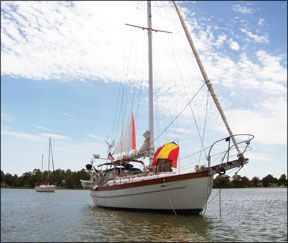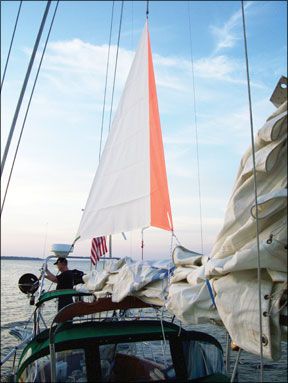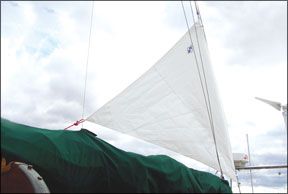Practical Sailor recently evaluated a radically new designed riding sail, the FinDelta Anchoring Sail from Banner Bay Marine, which uses three panels instead of the traditional single panel. According to Banner Bay, as the boat tries to swing, the sails forward fin generates a thrust vector to one side only, gently realigning the boat. By comparison, a traditional, single-panel anchoring sail still allows some degree of sailing at anchor as the sail backs and fills from one side to the other, often resulting in flogging. The FinDeltas design also reduces one of the most common complaints of traditional riding sail users: noise. The FinDelta doesn’t require attachment to the backstay-an excellent conduit to transmit the vibration from flogging anchor sail-and so noise is greatly reduced. While the single-panel riding sail has served sailors well for centuries, this new design intrigued our testers, and a head-to head-comparison between it and the traditional Sailrite riding sail was launched.
****

There are a few options when dealing with a boat that sails around on its anchor. A bridle, an all chain rode, or a kellet will reduce or eliminate sheering in lighter winds. However, a riding sail, which lessens yawing by bringing windage aft, is also a viable strategy. Ketches and yawls have the option of using their mizzen as a riding sail, but this unnecessarily exposes a working sail to sunlight and weather. A dedicated riding sail is a better choice for this situation. The riding sails
Practical Sailor examined for this comparison are suitable for use on a variety of rigs, including sloops or cutters.
Most riding sail manufacturers base their recommendations on vessel length; however, hull design and displacement are important considerations as well. Regardless, the sail cloth itself should be resistant to ultraviolet rays and chafe that can result from flogging as the sail backs and fills. While their benefits may be more pronounced in higher winds, riding sails are also useful in light air as they keep the vessel heading into the wind, maximizing airflow through hatches and wind chutes for ventilation belowdecks. In squalls, too big a riding sail can result in a 3 a.m. fire drill.
Traditional riding sails are typically a flat cut, heavily constructed single panel with heavy-duty stainless rings and closely spaced bronze hanks (for attachment to the backstay on a sloop). Theyre normally hoisted using the main halyard and are typically set with the head roughly a third of the way up the stay, which would be adjusted depending on conditions and your particular boat, lower being better in strong winds.
Practical Sailor
recently received and evaluated a radically new designed riding sail, the FinDelta Anchoring Sail from Banner Bay Marine, which uses three panels instead of the traditional single panel. While the traditional riding sail has served sailors well for centuries, this new design intrigued our testers, and a head-to head-comparison was launched.
A riding sail kit from Sailrite was purchased to represent the traditional riding sail. To help evaluate both sails from a sailmakers perspective, we turned to David W. Baxter, owner of Baxter Sailmakers, a well-respected loft in Norfolk, Va. (see article below). What follows is the first report on our findings.
The Sailrite Kit
Sailrite offers two riding sail kits for those wanting to try their hand at sailmaking. The smaller kit (for boats up to 35 feet, or so) is 12.5 square feet in area and costs $82, while the larger kit (for boats to 50 feet) is 20.25 square feet and runs $99. For the test boat, a heavy-displacement Union 36, we purchased the larger kit for our evaluation.

Both kits include all materials needed to construct the sail-pre-cut sail panels of white Top Gun fabric, thread, Seamstick, hanks, twine, hand needles, instructions, and a duffle bag for storage once the sail is completed. Sailrite advertises its choice of sail material (Top Gun fabric) as highly resistant to chafe and UV damage.
Rigging the Sailrite riding sail on a sloop is simple. Hank the sail onto your backstay, then sheet it forward. Traditional anchor sails are often sheeted so that they run down the boats centerline (like the fletch of an arrow), however a center-rigged sail produces the greatest potential for lateral movement as the sail backs and fills, which in itself can produce a jerky movement at the end of the anchor line and considerable noise from the sail itself.
Another option is to sheet the forward part of the sail to one side so that the boat is actually sailing to one side of the anchor rode. The boat should swing out until it reaches an equilibrium between wind and topside windage, where it should hold position fairly steady, while adjusting itself to minor changes in wind speed. Locking the rudder a few degrees to one side may also help keep the boat pointed in the same direction.
The Sailrite sail arrived too late to test in high-wind conditions, but we will be following up on the performance of both these designs in various conditions.
The FinDelta
Banner Bays FinDeltas three-panel design uses the forward or leading edge sail as an airfoil fin “spoiler,” while the two wings work constantly to center the boat, reducing the chance that the boat will start swinging.
According to Banner Bay, as the boat tries to swing, the sails forward fin generates a thrust vector to one side only, gently realigning the boat. By comparison, a traditional, single panel anchoring sail still allows some degree of “sailing” at anchor as the sail backs and fills from one side to the other, often resulting in flogging.

The FinDeltas design also reduces one of the most common complaints of traditional riding sail users: noise. The FinDelta doesn’t require attachment to the backstay-an excellent conduit to transmit the vibration from flogging anchor sail-and so noise is greatly reduced.
Analysis provided by Banner Bay through a NASA-funded Space Alliance Technology Outreach Program (SATOP) and conducted by University of Central Floridas Mechanical, Materials and Aerospace Engineering Department found that the FinDelta design is up to 26 percent more effective at realigning the boat, particularly during the early stages in the swing.
The FinDelta is available in two sizes, the FinDelta No. 1 ($325) for boats up to 35 feet and the FinDelta No. 2 ($375, the unit we tested) for boats from 35 to 47 feet. According to Banner Bay, a third size is on the way, the FinDelta No. 3 for boats over 47 feet (price was not yet available). All FinDelta sails are constructed of 6- and 7-ounce sailcloth (the fin is 7-ounce fabric, the wings 6-ounce fabric) and include a free storage bag and RopeTie cleat to snug your sail down.
Rigging the FinDelta is a bit more involved than a traditional riding sail, but the instructions are clear. After raising the sail the first time and determining how best to rig it to your particular boat, it takes only a few minutes to set up and remove. The sail is typically hoisted using the main halyard, although the topping lift or a spare halyard can also be used. Once raised, it assumes a three-sided pyramid shape with the forward fin secured around the boom (the fins bottom roughly 6 inches or less above the boom), and the wings attached aft, spread as close to a 45-degree angle as possible.
The FinDelta unit we tested had some modifications over the first model. Most of the changes were meant to make it easier to rig. In the new version, the base of the fin is a few inches longer and the base of the wings a few inches shorter. The sail is also a few inches taller to compensate for the loss in wing area. Grommets were added at the bottom of each wing a few inches back from the fin, allowing users to trim the ratio of fin and wing areas by pulling them together with a short piece of twine.
According to Jess Gregory, Banner Bay president, these modifications accomplish two things: the high-aspect ratio allows the sail to sit closer toward the stern (a position well aft is most desirable with an anchoring sail) and, as the wings are shorter fore to aft, it allows for a more desirable “spread” on boats with more narrow sterns.
Gregory told Practical Sailor that the biggest rigging problem results from extensive bimini arrangements on some boats that make it difficult to find a place at the stern to tie the wings without chafing the Sunbrella. In response, Banner Bay is developing a Check the Fit Kit, a likeness of the sails made of string. When tied at all attachment points it becomes a virtual wire frame outline of the sail.
Practical Sailor
conducted some initial testing with the FinDelta while at anchor during a weeklong trip on the Chesapeake Bay this past summer. After the initial trial-and-error period, we were able to raise and lower the sail in about 2 minutes.
During testing, we experienced a maximum of 10 to 15 knots of wind while at anchor. The FinDelta performed as advertised with no noticeable noise from the sail itself. At one anchorage, we experienced opposing wind and current conditions, and even when the boat was not aligned with the wind, the sail didnt flog excessively or produce an appreciable amount of noise.



































